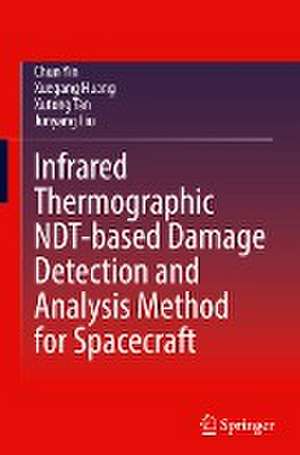Infrared Thermographic NDT-based Damage Detection and Analysis Method for Spacecraft
Autor Chun Yin, Xuegang Huang, Xutong Tan, Junyang Liuen Limba Engleză Hardback – 6 ian 2024
Preț: 895.58 lei
Preț vechi: 1092.17 lei
-18% Nou
Puncte Express: 1343
Preț estimativ în valută:
171.39€ • 177.06$ • 142.64£
171.39€ • 177.06$ • 142.64£
Carte tipărită la comandă
Livrare economică 26 martie-09 aprilie
Preluare comenzi: 021 569.72.76
Specificații
ISBN-13: 9789819982158
ISBN-10: 9819982154
Ilustrații: XVI, 267 p. 189 illus., 172 illus. in color.
Dimensiuni: 155 x 235 mm
Greutate: 0.58 kg
Ediția:1st ed. 2024
Editura: Springer Nature Singapore
Colecția Springer
Locul publicării:Singapore, Singapore
ISBN-10: 9819982154
Ilustrații: XVI, 267 p. 189 illus., 172 illus. in color.
Dimensiuni: 155 x 235 mm
Greutate: 0.58 kg
Ediția:1st ed. 2024
Editura: Springer Nature Singapore
Colecția Springer
Locul publicării:Singapore, Singapore
Cuprins
1 Background and Requirements.- 2 Infrared Feature Extraction and Damage Reconstruction.- 3 Reconstructed Thermal Image Fusion based on Multi-objective Guided Filtering.- 4 Stitching Technique for Reconstructed Thermal Images.- 5 Weight Vector Adjustment-based Multi-objective Segmentation of Thermal Images.- 6 Defects Positioning Method for Large Size Specimen.- 7 Defect Edge Detection and Quantitative Calculation of Reconstructed Thermal Images.
Notă biografică
CHUN YIN received the Ph.D. degree from the University of Electronic Science and Technology of China, in 2014. From 2011 to 2012, she was an Exchange Ph.D. Student with the Center for Self-Organizing and Intelligent Systems, Department of Electrical and Engineering, Utah State University, Logan, UT, USA. From 2012 to 2013, she was an Exchange Ph.D. Student with the MESA Lab, University of California, Merced, CA, USA. She was an Associate Professor with the University of Electronic Science and Technology of China, from 2014 to 2019. She has been a Professor with the School of Automation Engineering, University of Electronic Science and Technology of China, since 2019. Her research interests include multiobjective evolutionary optimization, infrared thermography testing, and hypervelocity impact engineering.
Seven of her articles have been listed as HOT article by Essential Science Indicators (ESI). One of her articles has been selected as the Top 5 list of Highly Cited Researchin the journal of Mechatronics, and one of her articles has been selected as the ScienceDirect Top 25 list of Most Download Articles. She received the Overall Best Paper Award in 2015 IEEE International Instrumentation and Measurement Technology Conference. She received the Best New Scholars Award of the University of Electronic Science and Technology of China. One of her technological achievements obtained the first prize for Scientic and Technological Progress Awards of Sichuan Province.
XUEGANG HUANG received the B.S. degree in materials science and engineering from Southwest Jiaotong University, and the M.S. and Ph.D. degrees from the Mechanical Engineering College, Shijiazhuang, China, in 2010 and 2014, respectively. His master's thesis was selected as the Excellent Master Dissertation of Hebei Province, in 2012 and his Ph.D. dissertation was chosen as the National Excellent Doctoral Dissertation of China, in 2017.
He has been working as an Associate Researcher with the Hypervelocity Aerodynamic Institute, China Aerodynamics Research and Development Center, China, since 2014. He has published more than 60 refereed journal articles in the above-mentioned fields. His research interests are in spacecraft measurement and control technology, space shielding engineering, hypervelocity impact engineering, and material dynamic behavior.
Seven of her articles have been listed as HOT article by Essential Science Indicators (ESI). One of her articles has been selected as the Top 5 list of Highly Cited Researchin the journal of Mechatronics, and one of her articles has been selected as the ScienceDirect Top 25 list of Most Download Articles. She received the Overall Best Paper Award in 2015 IEEE International Instrumentation and Measurement Technology Conference. She received the Best New Scholars Award of the University of Electronic Science and Technology of China. One of her technological achievements obtained the first prize for Scientic and Technological Progress Awards of Sichuan Province.
XUEGANG HUANG received the B.S. degree in materials science and engineering from Southwest Jiaotong University, and the M.S. and Ph.D. degrees from the Mechanical Engineering College, Shijiazhuang, China, in 2010 and 2014, respectively. His master's thesis was selected as the Excellent Master Dissertation of Hebei Province, in 2012 and his Ph.D. dissertation was chosen as the National Excellent Doctoral Dissertation of China, in 2017.
He has been working as an Associate Researcher with the Hypervelocity Aerodynamic Institute, China Aerodynamics Research and Development Center, China, since 2014. He has published more than 60 refereed journal articles in the above-mentioned fields. His research interests are in spacecraft measurement and control technology, space shielding engineering, hypervelocity impact engineering, and material dynamic behavior.
Textul de pe ultima copertă
The book focuses on infrared thermographic NDT systems and approaches. Both principles and engineering practice are covered, with more emphasis on the engineering practice of spacecraft damage detection and analysis. This is achieved by providing an in-depth study of several major topics such as infrared feature extraction, damage reconstruction, reconstructed image fusion, reconstructed image stitching, reconstructed image segmentation, defect positioning, defect edge detection and quantitative calculation. A number of application cases are discussed in detail, including impact damage to single-layer and multi-layer protective configurations, simple impact damage, and complex multi-type impact damage. The comprehensive and systematic treatment of practical problems in infrared detection and spacecraft damage identification is one of the main features of this book, which is particularly suitable for those interested in learning practical solutions in infrared detection technology. Thisbook can benefit researchers, engineers, and graduate students in the fields of aerospace design and manufacturing, spacecraft environmental engineering, and non-destructive testing technology, etc.
Caracteristici
Provides a comprehensive overview of the main characteristics and hazards of space environmental effects Illustrates the basic architecture of the infrared detection and assessment method for complex multi-type damage Uses real application objects and their computational examples for different data processing methods explanation
